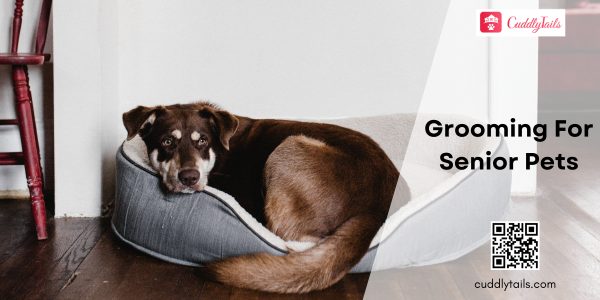Grooming for Senior Pets: Adjusting Techniques for Aging Animals
As our beloved pets age, their grooming needs change and require special attention and adjustments to ensure that they are comfortable and their well-being is taken into consideration. Senior pets may experience physical changes such as less mobility, stiff joints, and sensitive skin, making grooming techniques uncomfortable or a little difficult for them. In this blog, we will explore the importance of grooming for senior pets and discuss how to adapt to different grooming techniques to meet the unique needs of senior pets.
Understanding the Importance of Grooming for Senior Pets:
Grooming plays a crucial role in the overall health and happiness of senior pets. Regular grooming helps to keep their skin and coat clean and healthy, it helps in preventing matting and tangles, it also helps in reducing the risk of skin infections, and allows detection of any underlying health issues at an earlier stage. Additionally, grooming also provides an opportunity for bonding between pets and their owners, promoting a sense of comfort and security for aging animals.
Adapting Grooming Techniques for Senior Pets
When grooming senior pets, it is vital to approach the process with calmness, gentleness, and understanding of the pet’s unique and individual needs. Here are some tips for adapting grooming techniques for aging animals:
Brushing
Regular brushing is vital for maintaining the health and appearance of a senior pet’s coat. However, older pets may have sensitive skin or can be suffering from arthritis, making traditional brushing styles uncomfortable for them, to make them comfortable and adapt to the routine it is important to
- Choose a brush with a soft bristle or a grooming mitt to give maximum comfort.
- Brush gently and in short sessions to avoid causing any kind of stress or fatigue.
- Focus on areas prone to matting, such as behind the ears, under the chin, and the back legs.
- If your senior pet has difficulty in standing or lying down for grooming, it is advisable to use a raised platform or grooming table to provide support and stability to the pet.
Bathing
Bathing helps to keep your pet’s skin clean and free of dirt, dust, and any kind of odor. However, bathing very frequently or using any harsh shampoos can strip the skin of its natural oils and lead to dryness and irritation. To have a hygienic bathing routine it is advisable to take care of the following steps
- Use a mild, hypoallergenic shampoo specifically formulated for elderly pets.
- Bathe your pet in warm water which can help in soothing achy joints and muscles.
- Keep bathing sessions short to prevent fatigue and tiredness, and always rinse thoroughly to remove all traces of shampoo.
- After bathing, gently pat your pet dry with a soft towel, taking care to avoid vigorous rubbing.
Nail Trimming
Trimming your senior pet’s nails is essential for preventing overgrowth of the nails, which can lead to discomfort and difficulty in walking for your furry friend. However, older pets may have thicker nails or reduced blood circulation, making nail trimming more challenging. To adapt to the routine of nail trimming the following steps can be used:
- Use a pair of sharp, pet-safe nail clippers designed for senior pets to not make them anxious.
- Trimming small amounts of the nail at a time to avoid cutting as it can cause pain and bleeding and hence discomfort to the pet.
- If your pet is reluctant to have their nails trimmed, try desensitizing them by touching their paws and nails regularly and offering treats as a reward such as their favorite treats and activities.
Ear Cleaning
Regular cleaning of the ear can help in preventing ear infections and remove wax and dust that can accumulate over time. However, senior pets may have sensitive ears or reduced hearing, making ear cleaning more challenging. To overcome the challenge a few steps mentioned below can be used
- Use a gentle, pet-safe ear cleaner and cotton balls to clean the outer canal of the ear.
- Avoiding any type of object to be inserted into the ear canal to prevent injury or discomfort to the furry friend
- If your pet’s ears are sensitive or prone to ear infections then consult a veterinarian for guidance on appropriate cleaning techniques and products that are best for your furry friend
Professional Grooming
While grooming a senior pet at home is essential, pets also require professional grooming services that can provide additional benefits, such as expert handling and specialized equipment. When choosing a groomer for your senior pet, look for someone experienced in grooming older animals and knowledgeable about their specific needs.
Conclusion
Grooming for senior pets requires patience, understanding, and a willingness to adapt to their changing needs. By adjusting grooming techniques to accommodate the physical limitations and sensitivities of aging animals, we can ensure their comfort and well-being while maintaining their health and hygiene. It is therefore best to reach out to a professional groomer and a veterinarian to have a chat with and understand the changing needs of your furry friend. With proper care and attention, senior pets can continue to enjoy a happy, healthy life well into their golden years.

